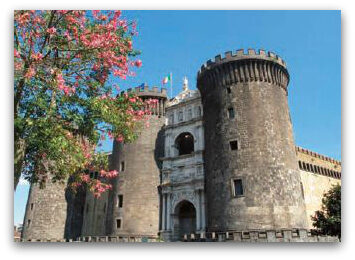Realised at the end of the XII century, under Charles I of Anjou, on a plan by the architect Pierre de Chaule. Thanks to its strategic position, the castle became both Royal Residence and fortress. It was called "Castrum Novum" (New Castle) to distinguish it from more ancient ones, Castel dell'Ovo and Capuano.
When the Crown of Aragon succeeded the House of Anjou (half of the XIV century), the king Alfonso I settled in and the fortress was upadated to resist the new artillery. The monumental structure was largely modified, on a project by Guillem Sagrera, adding great towers and a perimetral walkway to defend the entire structure.
The main gate presents, between the two towers, a marble triumphal arch, one of the most important work of the southern sculpture of the XV century, to celebrate Alfonso's entrance in Naples.
The complex, once centre of the City Council, is a Public Museum in 1990. To admire: exhibitions halls with paintings and sculptures (XIII - XIX centuries); the Palatina Chapel, the only testimony of the Anjou Royale Palace with fragments of frescoes by Giotto and its followers depicting Old and New Testament scenes; the Barons' Hall, once the "Sala Mayor" of the Angevin Castle, commissioned by Robert of Anjou and frescoed by Giotto with representations of great men of antiquity. Under the King Alfonso of Aragon (1442-1458), the Hall was remade and widened on a Sagrera's project who realised a wonderful stellar vault with a central oculus. The name refers to the arrest of the barons who plotted against Ferrante I of Aragon in 1486.
